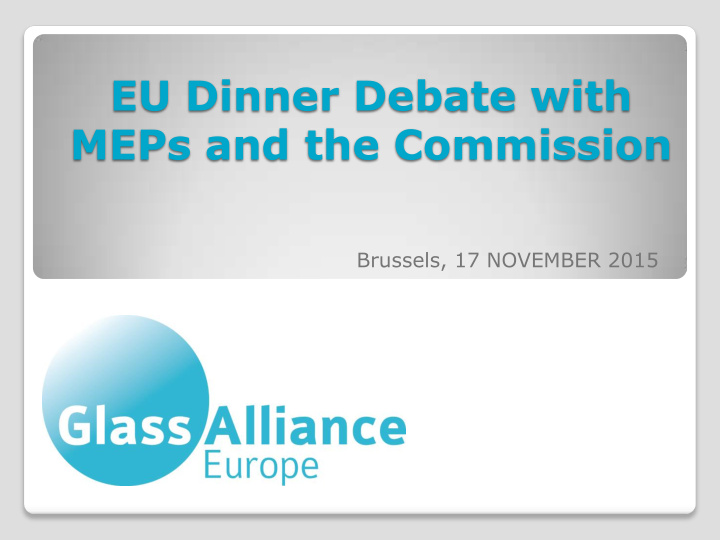



EU Dinner Debate with MEPs and the Commission Brussels, 17 NOVEMBER 2015
Introduction Who and what is Glass Alliance Europe? EU level alliance of sectoral and national bodies 14 national trade associations Flat, container, fibre, domestic and special glass sector organisations What do we do? Meet and work together collaboratively Common issues of environment, trade and social improvement – the pillars upon which we represent glass 2
Our footprint Europe is the largest glass manufacturing market in the world We represent: Over 500 manufacturing plants More than 500,000 jobs (direct and indirect) Growing at ~1-2% p.a. € 36 b contribution to GVA In 24 EU States spread across the whole of EU Producing 33 million tonnes 3
Distribution across EU states 4
All around us, at every moment of our lives 5
The world of glass An inert natural material mainly made of recyclate and widely abundant natural materials A circular economy thanks to a fully recyclable and in practice, highly recycled material A material appreciated for its health and comfort benefits, in preserving ingredients, transmitting natural light into buildings, etc In many applications serves to save energy or generate renewable electricity (eg windmills, insulation, photo-voltaics/solar cells) A sought-after aesthetics for designers and creators which contributes to brand reputation and Europe’s culture – provides “light and space” A material found in most leading products exported by the EU: food, automotive, luxury, technical, ITC 6
Innovation – glass is an enabler Glass innovation is a key enabler to Europe’s technological efforts in many sectors Flexible, theoretically almost unbreakable and stronger than steel Limitless design possiblities CO 2 saving – high performance glazing can save 100 million tonnes of CO 2 per year 7
Some interesting facts Glass has been in common use for millennia and remains a material of choice today It’s infinitely recyclable Its products save many times more carbon that its manufacture emits It’s the architects material of choice - providing “ space and light ” It’s the most inert of packaging materials It’s central to making wind-turbines for renewable energy generation 8
Some interesting facts (cont) It’s at the heart of the highest technologies in: ITC from fibre optic cables to next generation CPUs Biomedical implants and joint replacement Defence systems including laser photonics and LIDAR Intelligent communications and surface technologies Medical sensors for diagnosis and regulation Next-generation mobile phones, tablets and TVs Intelligent and self-regulating buildings Transport systems from planes and trains to cars and boats And this is just to mention a few … 9
Some of our notable achievements Typically improved our energy efficiency by ~28% over the last 20 years Reduced our CO 2 by > 10% since 1990 Reduced entry-level weight of typical containers by ~30% - without detriment Developed wide-range of intelligent coatings to support climate control in buildings and working spaces Developed thinner/stronger glass for phones/tablets and TV’s (Gorilla/Willow) Created novel materials for healthcare, defence, aerospace and architecture 10
Our hopes and aspirations The glass industry is positive and proactive, keen to attract support and investment in new research and development. We are looking to forge lasting relationships and a progressive dialogue to help us work with decision-makers in building a brighter, cleaner, healthier future around this truly amazing and multi-functional material. Dave Dalton,GAE PAC Chairman 11
Sectoral Stories 12
Perfume Value of European market: € 5.3bn Value of EU Exports: € 1.0bn 13
Champagne Value of the EU market: € 4.4bn Value of EU exports: € 1.2bn 14
Glass Products that rely primarily on glass for packaging represented a positive trade balance for the EU of more than € 21 billion per year 15
Message Glass packaging makes the product. Glass industry has been part of Europe’s territorial heritage . Think glass for a growing industry in a creative Europe. Marcello Montischi, FEVE PAC Chairman 16
The flat glass sector’s Carbon Balance ETS Reduction Energy needs & N CO2 emissions in melting process Building renovation Energy-efficient double & triple glazing solutions 10 1 Circular economy CO2 emitted due to Cullet collection, sorting CO 2 « gains » thanks activities in 1 year and recycling to products produced that year (performance during their entire lifetime) Energy label for windows Niels Schreuder, Glass for Europe / 17 FIV-VGI Belgian Glass Federation
Glass Alliance Europe wrap up Glass is everywhere – a global industry enabling many value chains 500.000 jobs, 500 EU plants Committed to growth, energy efficiency, waste reduction and decarbonisation Dialogue and build relations with you to keep glass production in the EU Ensure ETS protects against investment leakage Promote industrialisation and the circular economy Adeline Farrelly, GAE Secretary-General 18
Recommend
More recommend